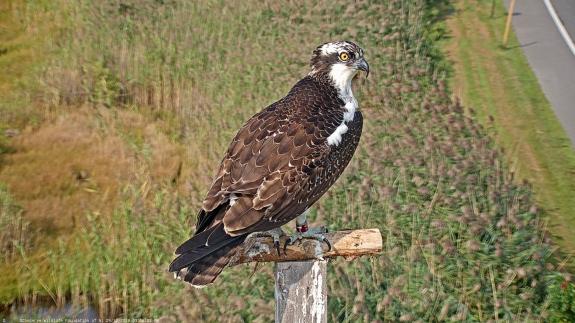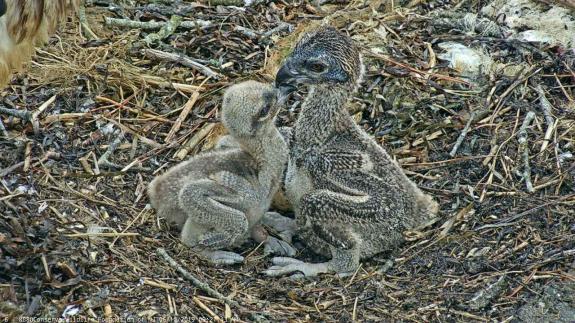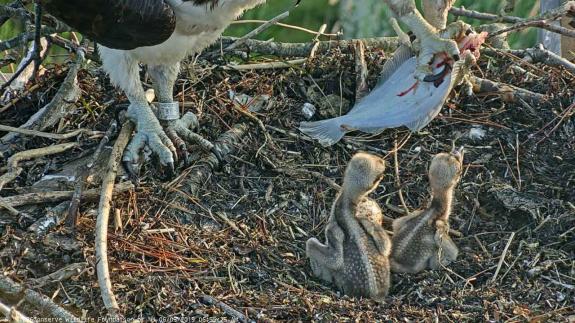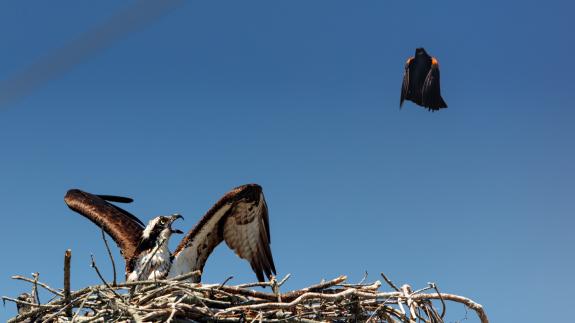2019 Nest Cam News
NestCam News from 2019 where two young were successfully raised during the first year of this new nest cam.
September 20
 46/K remained on the platform into the second week of September and long after her sibling had left to migrate south.
46/K remained on the platform into the second week of September and long after her sibling had left to migrate south.
Well, it's been fun watching 46/K who was reluctant to leave on her southbound migration until Monday, September 16. She was last seen on camera the night before. 46/K seemed to be content with starving until the male would deliver her a fresh catch. We knew it wouldn't be long until she would realize that she needs to start moving south as cold fronts with strong north winds give her that gentle push. Overall, most of our birds have left or will be leaving soon. Migration over Cape May peaks during the first week of October and last year just over 6,000 ospreys were counted at the hawk watch station there!! Do yourself a favor and get down to Cape May after a cold front with N winds blows through!
 46/K stands her ground and defends her nest to an immature gull!
46/K stands her ground and defends her nest to an immature gull!
As of right now, we are hoping to keep the camera online all winter. This will be a time for us to experiment with other streaming services, including going live on Facebook. This fall we'll be gathering video recorded from the camera to put together a "highlight reel" of awesome moments captured on camera this year. If you'd like to donate to support our costs to pay for internet ($125/month) then you can donate by clicking on the PayPal donate button on the left hand sidebar. Thank you to everyone for making this year such a great one!
 An empty nest marks the end of the breeding season.
An empty nest marks the end of the breeding season.
August 27
We visited the Osprey Cam yesterday to diagnose and hopefully repair the camera so that it could stream online again. Upon visiting the nest a juvenile (46/K) was calling repeatly for food from the adult male. As far as we know the adult female has left on her southbound migration (as most females do). It is believed that they do this to avoid flying through the tropics when the hurricane season is at its peak. We went through the steps of determing the issue with the camera system and determined that the power over ethernet injector (what powers the camera and transmits data to/from the web) was bad. Luckily, we had a spare PoE injector and after replacing it we saw the camera show up on the local network! Once we re-established the connections the camera was online. We then re-started the live stream on YouTube and updated our website with the embed code.
We were planning to keep this camera active during the summer months, but we are open to keep it online year round, despite the additional cost of internet, but we hope that some who would want to keep it online would donate to help us cover the cost of internet. If you're interested to see the camera remain online all winter then please let Ben Wurst know! Thank you to all viewers for your patience and understanding while the camera was down.
August 26
 A series of strong thunderstorms with high winds, heavy rain and lightning struck Barnegat Light on August 19. The camera went offline during the second round of storms.
A series of strong thunderstorms with high winds, heavy rain and lightning struck Barnegat Light on August 19. The camera went offline during the second round of storms.
Both young have fledged and have remained near the nest (though they aren't seen on camera). They are still dependant on the adults for food until they are able to forage on their own. Their southbound migration begins soon, but first they will disperse locally and work on honing their foraging skills.
On another note, the camera has been down since a bout of severe thunderstorms hit Barnegat Light on August 19. The camera witnessed the first line of storms which saw heavy rain, high winds (a gust of 52mph was recorded on a weather station in Loveladies), and lightning. When the second line of storms came, the camera went offline... As of right now, we can remotely access a network attached storage device on site but not the camera control, so the weather must have damaged the camera and/or POE injector. We are going to try and diagnose the camera system from the ground today and will post an update about the fate of the camera.
July 29
This morning around 8:15 osprey 46/K fledged! This was the first flight of the younger fledgling produced at this nest this year and around a week after her older sibling. Waiting to take their first flight is always good, since during this time of year we do see a number of young who end up on the ground or in the water as they fledge prematurely and are sometimes not strong enough to get airborne again. The strengthening of flight muscules is key to their successful first flight!
This is a wonderful time to visit the shore and watch as these young ospreys take to the sky and practice soaring, landing and foraging. A great place to watch them is right after sunrise on the ocean beach, especially during low tide, as they forage right in the surf for flounder and other small baitfish. To hunt is instinctual, but it takes skill for them to successfully find and catch prey. During this time of year they still rely on the adults for food and the nest to rest, but soon will disperse locally before beginning migration in September. The female is now able to forage to feed herself and her young and will use this time to rebuild fatty deposits before her long journey south in August. They are thought to depart first to their wintering grounds to avoid getting sucked into any tropical storm systems that develop more in the late summer/early fall when migration is well underway.
July 22
 The first flights of young osprey occur right over the nest, as they spread their wings, jump and flap to lift off!
The first flights of young osprey occur right over the nest, as they spread their wings, jump and flap to lift off!
The young produced at this nest are now approaching 8 weeks old and are able to fully fly on their own. If you've watched over the past week then you might have seen them flap, jump and then take short flights above the nest. Their feathers are fully developed and they are old enough to fly but they don't know it! As you can imagine, there must be a bit of hesitation, to leave the place where you grew up... First flights for young birds, especially large raptors like ospreys is very dangerous!! They have very high mortality rates in their first year of life. Once leaving the safety of their nest they can be hit by car, get electrocuted, get entangled, drown, or hit an object like a powerline. Our infrastructure is robust and built for us to live our daily lives, but to a bird there are many deadly obstacles.
July 12
On the morning of July 1, Ben Wurst assisted by volunteer Northside Jim visited this nest and banded both young for future tracking. We streamed the banding live on YouTube (see above). Since 2014, young produced at nests on B. Bay have been banded with a red aux. band to help track them while alive. Their bands are 45/K & 46/K. These "field readable" bands help us to learn more about their movements, including local dispersal, migration routes, foraging habits, nest site fidelity, and life span. They also help us to engage citizen scientists in osprey management and conservation in NJ as it gets more people interested in watching ospreys and reporting nest activity online on Osprey Watch. We will deploy a total of 500 red bands on B. Bay since the beginning of the project.
When we survey nests and band young, we do not sex the young. This would need to be done when young are around 7 weeks old and at more of a risk of jumping from their nest when we would visit it. Also, it would take considerable more time at the nest, with the adults up in the air. We try to minimize the amount of stress that we cause these birds and conduct surveys when it is not too hot and don't band all young that are produced (to reduce time at the nest). Banding is secondary to determining outcome at nests. Last year we banded around 25% of all young observed in NJ.
These nestlings are now around 6 weeks old and you will start seeing them flap more and jump. This helps to strengthen their wing muscles to prepare for their first flight, which occurs when they are around 7-8 weeks in age. Once they fledge or make their first flight, they will still rely on the adults for food until they learn the skills needed for them to successfully catch fish on their own. This is a dangerous time for young birds. They can perch on a utility pole and get electrocuted, hit a wire or get struck by a motor vehicle. Mortality rates of young ospreys (and other birds of prey) is very high ~ 80%. Their chances of surviving to adulthood improve after their first year of life. They will migrate south in September and remain on their wintering grounds for the next two years.
June 25
 The nestlings, who will be four weeks old on 6/29-7/1, eat around half their body weight every day to grow as fast as they do!
The nestlings, who will be four weeks old on 6/29-7/1, eat around half their body weight every day to grow as fast as they do!
This is the nestling period for almost all osprey nests in New Jersey. If a pair is still incubating eggs at this time, then it usually indicates that one of the adults is new and/or they are less experienced than those who have 3-4 week old nestlings, like at this nest. The nestlings here are now 25 days old! They hatched on May 29/June 1. As you can see when you watch the live feed, they require A LOT of fish! Staples along the coast are menhaden, a forage fish and flounder, a bottom feeding fish. In times when prey is not plentiful then the youngest nestlings often starve. Luckily this is not the case here and at other sites throughout coastal NJ b/c prey has been plentiful.
In other news, we are planning to band both young at this nest on Monday, July 1 at around 9am. Thank you to United Rentals for giving us a discount for renting a man-lift to access the nest!!
June 10
 Two nestlings (9 & 12 days old) will soon take priority and be too big to brood by the adult female. The chance of the remaining egg hatching are slim.
Two nestlings (9 & 12 days old) will soon take priority and be too big to brood by the adult female. The chance of the remaining egg hatching are slim.
The female has been sitting tight while trying to incubate her remaining egg, which has passed the incubation range for hatching, which was 42 days. Today is day 45 so the chances that it will actually hatch are slim to none, but she will persist and continue to incubate until her young are too big to brood and take more of her time. Two young are plenty for a pair to raise and care for. If that third egg would hatch, then that young (the runt) would have a really hard time competing for food from the adults, especially if food is scarce. Ospreys exhibit brood reduction in areas where prey is not plentiful. Luckily that has not been a problem in much of NJ.
We're planning to band both young at this nest on Monday, July 1 at around 8:30am. We will stream the banding live on YouTube. We will update this page if anything changes. If you subscribe to us on YouTube, then you can be notified when we "Go Live!" -Ben
June 4
 Two hatchlings about to be fed flounder, a staple at nests during the nestling period in NJ.
Two hatchlings about to be fed flounder, a staple at nests during the nestling period in NJ.
The first hatchling was visible on May 29 in the early morning (first feeding) and then the second was observed on June 1. We're still waiting to see if the third egg will hatch. When we get a feeeding tomorrow morning I will zoom in closely to look for a pip. Tomorrow will be day 40 of incubation for that egg, so it is not too late to lose hope!
 A persistant blaclbird in attack mode on the nesting ospreys in 2018. photo by Northside Jim
A persistant blaclbird in attack mode on the nesting ospreys in 2018. photo by Northside Jim
Many have noticed the repeated attacks by the red-winged blackbird on the adults here. Unfortunately, there is nothing we can do. This was even observed at this nest last year (click for a photo from Northside Jim in 2018), so this is nothing new for these birds...
May 28
 A pip in the first egg on May 28, 2019.
A pip in the first egg on May 28, 2019.
Ospreys exhibit asyncronous incubation and hatching, where they start incubating after the first egg is laid. This is a natural adaption, where eggs hatch in the order that they are laid (at typical intervals of every 2-3 days). Therefore, there are age differences in the young. This adaptation is how they can deal with shortages in prey availability. If there is not enough prey to feed all young, then brood reduction occurs then the youngest and weakest hatchling will not survive. Luckily we have had plenty of prey to allow for broods of 2-3 young throughout New Jersey, so this is not something that we will likely at this nest.
Today marks day 38 of incubation for the first egg, which has pipped! A pip in an egg is where the hatchling breaks through the shell with its egg tooth. It can take several hours for the hatchling to fully emerge from its shell. They hatch as semialtricial young, meaning that they are downy and can see, but need close parental care.
May 6
 The suffix of the USGS bird band (49033) allowed us to identify the breeding male at this nest.
The suffix of the USGS bird band (49033) allowed us to identify the breeding male at this nest.
As many of you who have watched the cam have seen, both the male and female take turns incubating the eggs. The female does the majority of incubation (and all other nest duties including brooding, shading and feeding young) while the male does 100% of the foraging. Therefore, the success of their nest attempt is largely due to the males ability to find and catch prey, esp. once they have young. The female gets a break from incubating to stretch her wings to feed and preen off the nest (you won't see them feed on the nest until after they have young - this is to avoid attracting any predators). Then the male gets a chance to relax and help incubate their clutch of eggs.
I was so excited to see that the male at this nest was banded! Getting a good snapshot of his band was the first thing that I did with the camera after we got it connected. After reading part of his band number (xxxx-49033) I was able to search for his band in our banding database. He was banded as a nestling on July 12, 2006 at nest 123-A-013 inside Sedge Islands WMA (only 2.61 miles from this nest!). I've banded many young ospreys inside Sedge, but this bird was banded by Tom Virzi, a researcher who was living in NJ and volunteered to survey nests and band young at Sedge for a couple years. I took over for Tom in 2008 and have been surveying nests there since then. I reached out to Tom to let him know and see if he had any photos from his time banding at Sedge, but he hasn't gotten back to me yet. Hopefully he does, b/c we love to see photos and hear stories about young birds after they are re-sighted as adults!!
 Zoom+ Ben Wurst geeks out while port forwarding connections to get the osprey cam online. photo by Northside Jim
Zoom+ Ben Wurst geeks out while port forwarding connections to get the osprey cam online. photo by Northside Jim
It is rare to get a re-sighting of a live federally banded bird, since most re-sightings are attributed to that bird being found injured or dead. This is mainly because these aluminum leg bands are very hard to read. In 2014 we began to band young ospreys produced on Barnegat Bay nests, called Project RedBand, with an auxiliary or "field readable" red bands, which allow us to gain information on them when they're alive. Just a couple weeks ago we had an intruder come into this nest and we saw that the bird was banded with a red band! We have not been able to confirm the band, but we believe it is 45/C, a young bird that was banded at Sedge in 2014. We hope to see 45/C again to confirm her band.
The one thing I wonder: where did this experienced male, who will be 13 years old this summer, breed before here? BW
April 26
 An incubation exchange reveals three eggs!
An incubation exchange reveals three eggs!
The pair is now on a full clutch of three eggs! The second was laid early on April 23 and the third egg was laid early this morning. Since ospreys begin incubating after they lay the first egg, this puts hatch watch to begin around Memorial Day weekend (day 36 of egg #1). The length of incubation varies from 36-42 days. At our old osprey cam they tended to incubate for around 40 days. Eggs will hatch in the same order as laid. This is a natural adaptation where in food shortages only the oldest (and strongest) nestlings will survive. Last year this pair produced two young and the male is twelve years old, so he is experienced with finding and catching prey, so hopefully prey is plentiful this summer and all young will survive!
We reached out to the bander of the 12 year old male and have not heard back, but in the next NestCam News, we will share more information about him.
Thank you to The Sandpaper for writing a great story about this new camera system! BW
April 20
 The first egg was laid around 10am on April 20.
The first egg was laid around 10am on April 20.
After some wet weather overnight, the stream went offline at some point this morning. At around 10am this morning the female laid the first egg! Once the internet speeds improved and the streaming server was reset, we got the stream back online.
We can expect her to lay another egg in 2-3 days. Hatch watch will begin around Memorial Day.
April 17
 Zoom+ Our outdoor enclosure which houses electrical equipment for the camera.
Zoom+ Our outdoor enclosure which houses electrical equipment for the camera.
Our internet service was finally install on Sunday, April 14th. The day after, we visited the site to finish networking the camera system. Luckily we were able to finish most of the sensitive wiring before a cold front with heavy rain and high winds hit the area. We then moved into a vehicle and connected to the camera to finish setting it up on the local network. While there the birds did not mind our presence at all. This is what's great about ospreys who nest atop a tall pole, like here (the pole is around 35' tall). It gives them space from any kind human activity below and the height of the nest allows them to see everything around them.
Last year was the first year that this nest was occupied and they had two young who banded with help from Atlantic City Electric. The banding was featured in this trailer that we had produced to showcase our work with ospreys in New Jersey.
We expect the female here to lay her first egg anytime now. She hung by the nest all night last night, so that indicates that she is likely to egg an egg in the next 24-48 hours (from our other observations at our former osprey cam). BW
April 4
 The new osprey cam installed on the tall nest platform in Barnegat Light. April 5, 2019.
The new osprey cam installed on the tall nest platform in Barnegat Light. April 5, 2019.
Thank you to everyone who has watched and supported the Osprey Cam at Edwin B. Forsythe NWR in Oceanville with us over the years! Last year we decided to pursue a new nest for installation of a new camera system after experiencing difficulties with this one. Over the past several months we have been working to build and install the new system at a nest on the bay in Barnegat Light. It was installed during the last week of March and we hope to get it online before the end of the second week in April.
Even though we aren't streaming the Osprey Cam here, it doesn't mean we aren't involved with it. We can be considered as "silent partners" on it. This spring we conducted repairs at the Forsythe Osprey Cam to replace the two Type 24 deep cycle batteries and a PoE network switch. After that, we worked with USFWS IT to make sure the network settings were configured correctly and then helped the Friends of Forsythe get the camera streaming online. We are still working with them to get the audio stream online, since that is still working and an important aspect of sharing the lives of ospreys on the saltmarsh! We are going to help them get a discussion page setup so that people can comment and share photos from the camera like you always could on our website. We will remain involved with this camera to be sure it will stay online for everyone to enjoy! The camera stream can now be viewed from this page via the Friends of Forsythe NWR.
Find Related Info: Osprey




